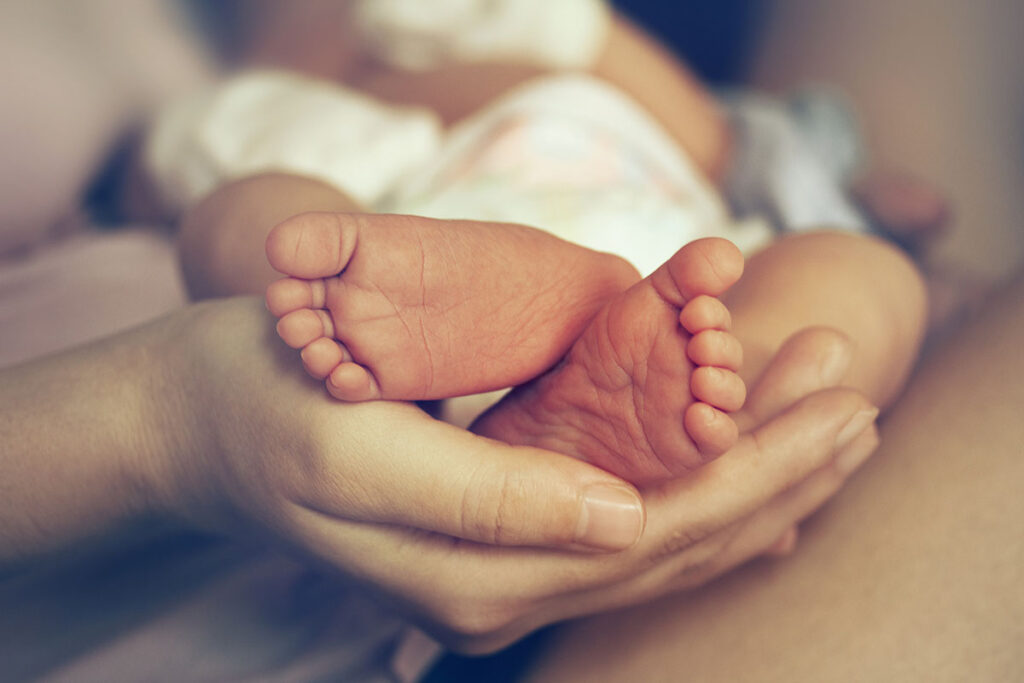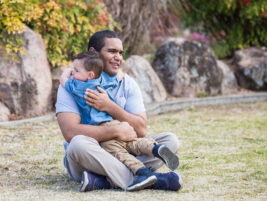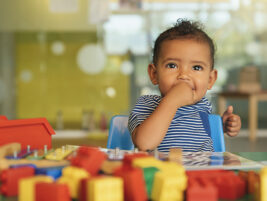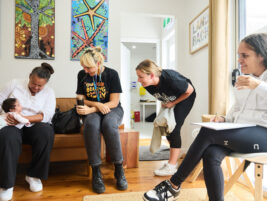Introduction
Kai von Klitzing’s article, published in the previous issue of Perspectives in Infant Mental Health (von Klitzing, 2024), well describes the tension between a “culturally sensitive approach” that acknowledges multiple acceptable pathways to young children’s mental health and “cultural arbitrariness” which constitutes indiscriminate acceptance of virtually all cultural practices. We appreciate his raising complex issues regarding the potential limits of diverse pathways to healthy mental development, particularly ethical questions about the impact of the newer reproductive technologies on the “future child’s” experience. We recognize that the use of reproductive technologies presents challenges to the sorting of what are “acceptable” and “unacceptable” pathways which are being debated by practitioners, researchers, legal scholars, religious adherents, and policymakers in countries around the globe. Our response addresses Professor von Klitzing’s assertions and questions regarding non-traditional approaches to conceiving and raising children.
Is there really a rights-based ethical dilemma?
Klitzing proposes that an ethical dilemma exists because of the coexistent “rights of adults to fulfill their desire to have children” and “the rights of unborn and newborn children to develop and grow up under the best possible conditions.” This argument requires at least three premises: 1) there is a rights-based claim held by adults to fulfil their desire to have children, 2) there is a rights-based claim held by unborn and newborn children to develop and grow up under the best possible conditions, and 3) that these rights claims are incompatible, giving rise to an ethical dilemma.
We argue that these premises are not justified, and therefore the conclusion about this ethical dilemma is premature. There are notable conceptual weaknesses of a rights-based claim to grow up under the best possible conditions (we will call this the “best possible conditions claim”), and we disagree with the assertion that the adult’s access to parenthood and the child’s access to “the best possible conditions” are mutually exclusive (we will call this the “dilemma claim”).
Though not completely clear from his paper, Klitzing seems to be adopting an interest-oriented theory of rights, where rights include “the protection of an interest of sufficient importance to impose on others certain duties, whose discharge ensures the enjoyment by the rightsholder of the interest in question” (Archard, 2015, p. 58). To accept the proposed dilemma of incompatible rights, we must be convinced that unborn and newborn children have such a strong interest in growing up under the “best possible conditions,” that a positive duty exists for others to provide this (i.e., that it is essential to their wellbeing).
The “best possible conditions claim,” appears to be an allusion to the “best interests of the child” account of surrogate decision-making. This account assumes a clear, knowable, objective, and universal standard that supports the optimal development and wellbeing of children.
The “best interests standard” has been the subject of much debate in the bioethics literature (e.g., Archard, Cave & Brierley, 2024; Auckland & Goold, 2019; Rhodes & Holzman, 2014; Salter, 2012). Critics have cited concerns that the “best interests standard” is subjective, indeterminate, polarising, paternalistic, individualistic, and overlooks the harms of overriding parental decisions, among other problems. Furthermore, a systematic review of the normative literature on overriding parental decision-making revealed “a substantial consensus among ethicists that harm [not best interests] is the central moral concept when judging the appropriate threshold for state intervention in parents’ medical decision-making” (MacDougall & Notini, 2014 p. 452).
Klitzing’s “best possible conditions claim” illustrates some of the weaknesses in the best interests standard. Firstly, there is the problem of how to — and who should — decide on what these “best possible conditions” are. Certainly, there is strong scientific evidence for the minimally acceptable conditions required for normal child development, i.e., the basic needs to be met and freedom from maltreatment and other serious adverse experiences (e.g., WAIMH, 2016; Felitti et al., 1998). But beyond these “good enough” conditions, normal child development can occur in a wide variety of caregiving conditions — the equifinality that Professor von Klitzing discusses in the first section of his paper. Therefore, we must return to first principles regarding the special moral claim that parents have, to raise their children in accordance with their own values, based on their own beliefs about what is in their child’s interest, without external interference — except where the child is subject to, or at serious risk of, significant harm.
Secondly, there are the adverse consequences of insisting on a “best possible conditions” standard. There is, already, concern about the overreach of state agencies in “policing” families, and the intergenerational harms that can come from this, leading some to call for the abolition of the child welfare system altogether (e.g., Dettlaff, 2023). Although we do not support this conclusion, it is clear that state intervention in the affairs of families is a complex and serious business that should be oriented towards supporting families to thrive. This requires a sufficiently high threshold for more coercive practices, such as legally mandated surveillance or removal of children from their families. A “best possible conditions” standard is a very low threshold, which leads to several questions, including: What should happen when a child is not being raised in the “best possible conditions,” and should this include state intervention? Which groups in society are likely to be disproportionately affected by a “best possible conditions” standard, and does this reinforce the structural oppression of minoritised groups? How can a “best possible conditions” standard be fairly and realistically applied when there will always be complex social challenges, new and old, that children and families cannot control but have to navigate. In short, asserting a child’s right to grow up in the “best possible conditions” without adequately explaining what this means or how it could be upheld without causing systematic harm to vulnerable families, seems problematic.
Even if we accept that unborn and newborn children should have access to “good enough” conditions (e.g., Saunders, 2021)—a more modest and more defensible claim– there is a problem with formulating the relationship between the right to parenthood and the right to good enough care as a dilemma. A true ethical dilemma occurs when it is impossible to fulfill all the duties one is bound to. That is, to fulfill one duty is to violate another. In making a “dilemma claim,” Klitzing is arguing that it is not possible for certain would-be parents (i.e., those unable to conceive without assistance) to fulfill their desire to have children and for those children to grow up under good enough conditions. He questions the strength of the evidence around the developmental outcomes of children who grow up in non-traditional family constellations (see below). The fact that there are methodological limitations in such research and that definitive proof awaits future study, is hardly surprising and an issue for much research linking caregiving to child outcomes. Nevertheless, there is no evidence that we have seen that indicates that children cannot (or are even less likely to) grow up under good enough conditions when they have been raised by parents who have conceived using reproductive technologies. There is, in fact, research to suggest that parents who conceive through artificial reproductive techniques are highly sensitive and non-intrusive, perhaps because they are highly motivated (Ellis-Davies et al., 2022).
Our concern is that conflating the known harms associated with child maltreatment with the (actually positive) developmental outcomes of children conceived by reproductive technologies risks creating baseless anxiety and playing into political agendas that seek to restrict the access to reproductive technologies for minoritized groups. Portraying the coexistent interest of adults to be parents and of children to receive good enough care as an ethical dilemma is at best misleading, and at worst harmful to these families.
We acknowledge that the interests of parents and young children are not identical, and there will sometimes be tension between these interests. But accepting that parents and their children have distinct interests is not the same as accepting that these interests are incompatible.
Narcissistic Investment in Traditional and Non-traditional Parents Alike
Klitzing seems to suggest that babies conceived through reproductive technologies are at risk because they are expressions of parental self-fulfillment at the expense of the baby’s developmental needs. Why do we think that self-centeredness is more likely to be associated with non-traditional conception? Citing psychoanalytic theory, Klitzing notes that narcissism plays a role in parent-child relationships. He says that “Initially, parents turn to their babies because they seem to be a part of themselves and promise to fulfill narcissistic needs beyond the parental life span. But the narcissistic satisfaction of having a child comes into competition with the parents’ own egoistic needs…”. Prioritizing another’s needs ahead of one’s own needs is the sine qua non of healthy parenting and other loving relationships. Raising children necessarily entails stress and drudgery that in healthy parent-child relationships is more than counter-balanced by profound joy. This is the narcissistic balance between love and hate that Professor von Klitzing describes. But is this “balance” less likely for non-traditional parents?
Fortunately, humans have the capacity for healthy narcissistic investment in children, even without bearing them (e.g., biological fathers) or having a biological tie to them (e.g., foster, adoptive and stepparents). Millennia before sophisticated reproductive technologies and legally sanctioned adoptions, adults cared for non-biological children and—consider Moses, Aristotle, Muhammad–all raised and loved by non-biological parents.
It will be some time before we have a meta-analysis of hundreds of studies of the effects on children of the kinds of non-traditional parenting associated with reproductive technologies described by Klitzing. Nevertheless, findings to date also are mostly reassuring about children raised following surrogacy (Patel et al., 2020; Yau et al., 2021) and from IVF (Hart & Norman, 2013; Heinemann et al., 2019; Kennedy et al., 2023).
To be sure, there are complex cultural, ethical and human rights issues involved in surrogacy. In our view, however, it is possible to condemn categorically the exploitation of desperately poor women without condemning all adoptions or surrogacy. An ethical perspective requires appreciating complex distinctions, nuanced analysis and careful language.
Same-sex Parent Families
Klitzing expresses concern about children of homosexual parents even as he notes that there is little evidence to support his concern. On this latter point, we agree: the past 40 years have produced a substantial body of research examining the health, development and well-being of children raised by parents who identify as gay or lesbian and multiple reviews that summarize this literature (e.g. Manning et al., 2014). Overall, this research has found little evidence of developmental risks to the child. This is especially noteworthy given that much of this research was conducted during a time of little (or at least slowly growing) acceptance of gay and lesbian parenting, so that often these parents were operating without the same supports and legal rights afforded to heterosexual parents. The resilience of these families is frequently noted in the literature, and given changes in attitudes towards gay and lesbian parents in many parts of the world, there have been recent calls to re-orient contemporary research away from an assumption of deficits and towards examinations of stress and resilience within same-sex parent families (e.g., Mazrekaj et al., 2022), just as we would for families with heterosexual parents.
Conclusion
Professor von Klitzing suggests that our field of infant mental health should weigh in on the questions of how, why, and by whom babies are conceived, citing concerns about the limits of equifinality. Such considerations may be clinically relevant, and the journey to parenthood may be included in therapeutic conversations, but clinical attention typically focuses on ensuring the infant has “good enough” experiences within their caregiving relationships to promote their healthy development. Our profession has expertise to guide and inform parenting, however it is important to remember recent historical examples of societal overreach on matters of procreation. For example, the eugenics movement during the late 19th and early 20th centuries sought to improve health, social, and intellectual characteristics through selective breeding (National Human Genome Research Institute [NHGRI], 2022). Nicholai Ceausescu’s 1966 Decree 770 sought to increase the Romanian population by preventing contraception and abortion. Both examples resulted in tragic outcomes for thousands of women, children, and families and while extreme, they do provide a cautionary note about possible implications of state or professional-determined decisions about procreation and reproductive health.
If we as clinicians and child advocates are going to draw lines about unacceptable or maladaptive pathways—the “roads” which do not “lead to Rome”–these lines ought to be drawn cautiously and conservatively, informed by clear evidence of harm. Using this criterion, we are on quite solid grounds to stand against violence towards children, for example. In the absence of compelling data indicating harm, it seems wise and salubrious to maintain the therapeutic ethos and unique contribution of the infant mental health field, which has been to strengthen the development and well-being of young children within their important relationships, rather than judge how families are formed.
References
Archard, D. (2015). Children: Rights and childhood. New York: Routledge.
Archard, D. Cave, E., & Brierly, J. (2024). How should we decide how to treat the child: Harm versus best interests in cases of disagreements. Medical Law Review, 32(2), 158-177. https://doi.org/10.1093/medlaw/fwad040
Auckland, C., & Goold, I. (2019). Parental rights, best interests and significant harms: Who should have the final say over a child’s medical care? Cambridge Law Journal, 78(2), 287–323. https://doi.org/10.1017/S0008197319000382
Dettlaff, A. J. (2023). Confronting the racist legacy of the American child welfare system : the case for abolition. Oxford University Press. https://doi.org/10.1093/oso/9780197675267.001.0001
Ellis-Davies, K., Van Rijn-van Gelderen, L., Winstanley, A., Helmerhorst, K. O., Rubio, B., Vecho, O., … & Bos, H. M. (2022). Parental sensitivity and intrusiveness in gay-, lesbian-, and heterosexual-parent families with infants conceived using artificial reproductive techniques: Do parents’ gender and caregiver role matter? Early Childhood Research Quarterly, 58, 177-187.
Gillam, L. (2016). The zone of parental discretion: An ethical tool for dealing with disagreement between parents and doctors about medical treatment for a child. Clinical Ethics, 11(1), 1–8. https://doi.org/10.1177/1477750915622033
Felitti VJ, Anda RF, Nordenberg D, Williamson DF, Spitz AM, Edwards V, Koss MP, Marks JS. Relationship of childhood abuse and household dysfunction to many of the leading causes of death in adults. The Adverse Childhood Experiences (ACE) Study. Am J Prev Med. 1998 May;14(4):245-58. doi: 10.1016/s0749-3797(98)00017-8. PMID: 9635069.
Hart, R. & Norman, R.J. (2013). The longer-term health outcomes for children born as a result of IVF treatment. Part II–Mental health and development outcomes, Human Reproduction Update, 19(3), 244–250.
Heineman, K.R., Kuiper, D.B., Bastide-van Gemert, S., Heineman, M.J., Hadders-Algra. M. (2019). Cognitive and behavioural outcome of children born after IVF at age 9 years. Human Reproduction, 34(11):2193-2200.
Kennedy, A.L., Vollenhoven, B.J., Hiscock, R.J., Stern, C.J., Walker, S.P., Cheong, J.L.Y., Quach, J.L., Hastie, R., Wilkinson, D., McBain, J., Gurrin, L.C., MacLachlan, V., Agresta, F., Baohm, S.P., Tong, S., Lindquist, A.C. (2023). School-age outcomes among IVF-conceived children: A population-wide cohort study. PLoS Medicine, 24;20(1):e1004148.
Manning, W. D., Fettro, M. N., & Lamidi, E. (2014). Child well-being in same-sex parent families: Review of research prepared for American Sociological Association Amicus Brief. Population research and policy review, 33, 485-502.
Mazrekaj, D., Fischer, M. M., & Bos, H. M. (2022). Behavioral outcomes of children with same-sex parents in the Netherlands. International journal of environmental research and public health, 19(10), 5922.
McDougall, R. J., & Notini, L. (2014). Overriding parents’ medical decisions for their children: a systematic review of normative literature. Journal of Medical Ethics, 40(7), 448–452. https://doi.org/10.1136/medethics-2013-101446.
National Human Genome Research Institute, U.S. (2022) Retrieved from https://genome.gov/
Patel, A., Kumar, P., Sharma, P.S.V.N. (2020). The miracle mothers and marvelous babies: Psychosocial aspects of Surrogacy – A narrative review. Journal of Human Reproductive Science, 13(2), 89-99.
Patel, A., Kumar, P., Sharma, P.S.V.N. (2020). The miracle mothers and marvelous babies: Psychosocial aspects of Surrogacy – A narrative review. Journal of Human Reproductive Science, 13(2), 89-99.
Rhodes, R., & Holzman, I.R., (2014). Is the best interest standard good for pediatrics? Pediatrics (Evanston), 134 Suppl 2(Supplement_2), S121–S129. https://doi.org/10.1542/peds.2014-1394H
Salter, E. K. (2012). Deciding for a child: a comprehensive analysis of the best interest standard. Theoretical Medicine and Bioethics, 33(3), 179–198. https://doi.org/10.1007/s11017-012-9219-z
Saunders, B. (2021). A sufficiency threshold is not a harm principle: A better alternative to best interests for overriding parental decisions. Bioethics, 35(1), 90–97. https://doi.org/10.1111/bioe.12796
von Klitzing, K. (2024). “There are many roads leading to Rome”. Growing up in a diverse world; does everything work in child development? Perspectives in Infant Mental Health 32 (2) 11-17.
World Association of Infant Mental Health [WAIMH]. (May 13, 2016). WAIMH position paper on the rights of the infant. Perspectives in Infant Mental Health, https://perspectives.waimh.org/wpcontent/uploads/sites/9/2017/05/PositionPaperRightsinfants_-May_13_2016_1-2_Perspectives_IMH_corr.pdf
Yau, A., Friedlander, R.L., Petrini, A., Holt, M.C., White, D.E., Shin, J., Kalantry, S., Spandorfer, S. (2021). Medical and mental health implications of gestational surrogacy. American Journal of Obstetrics & Gynecology, 225(3), 264-269.
Authors
Alison Steier,
United States
Izaak Lim,
Australia
Paula Zeanah,
United States
Charles Zeanah,
United States
Jon Korfmacher,
United States








